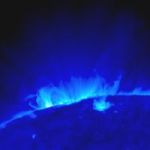 For the first time since its October Launch, the twin-spacecraft STEREO project is producing and sending back images of the Sun. Projects like these are important to understanding the effects of the Sun on our climate and environment. The more that we know about this, the better we are able to further disarm global climate alarmist fantasies about anthropogenic effects.
For the first time since its October Launch, the twin-spacecraft STEREO project is producing and sending back images of the Sun. Projects like these are important to understanding the effects of the Sun on our climate and environment. The more that we know about this, the better we are able to further disarm global climate alarmist fantasies about anthropogenic effects.
Image right: A close up of loops in a magnetic active region. These loops, observed by STEREO’s SECCHI/EUVI telescope, are at a million degrees C. This powerful active region, AR903, observed here on Dec. 4, produced a series of intense flares over the next few days. Credit: NASA
NASA’s twin Solar Terrestrial Relations Observatories (STEREO) sent back their first images of the sun this week and with them a view into the sun’s mounting activity.
One image shows the first coronal mass ejection (CME) observed by STEREO’s Ahead spacecraft, taken Dec. 9.
The other two images show the sun’s super-hot atmosphere. They were taken on Dec. 4, the first day of imaging observations for the Ahead spacecraft. The false color images show a number of bright magnetic active regions, including one on the far left edge of the sun which later produced a series of high energy flares and CMEs.
“We’re absolutely thrilled. We’ve been looking forward to STEREO’s unique vantage point for over 10 years now and the community couldn’t be happier with these first views,” said Michael Kaiser, STEREO project scientist at NASA Goddard Space Flight Center, Greenbelt, Md.
“Now we’re holding our breath to see what the next big CME looks like in 3-D, so we can really start to answer some interesting questions.”
After a successful launch on Oct. 25 from Cape Canaveral Air Force Station, Fla., STEREO spent the first few minutes separating from its stacked configuration aboard the single Delta II rocket. Shortly afterwards, mission operations personnel at The Johns Hopkins University Applied Physics Laboratory, (APL) Laurel, Md., monitored the two observatories as they traveled in an elliptical orbit from a point close to Earth to one extending just beyond the moon.
Rani Gran
Goddard Space Flight Center
